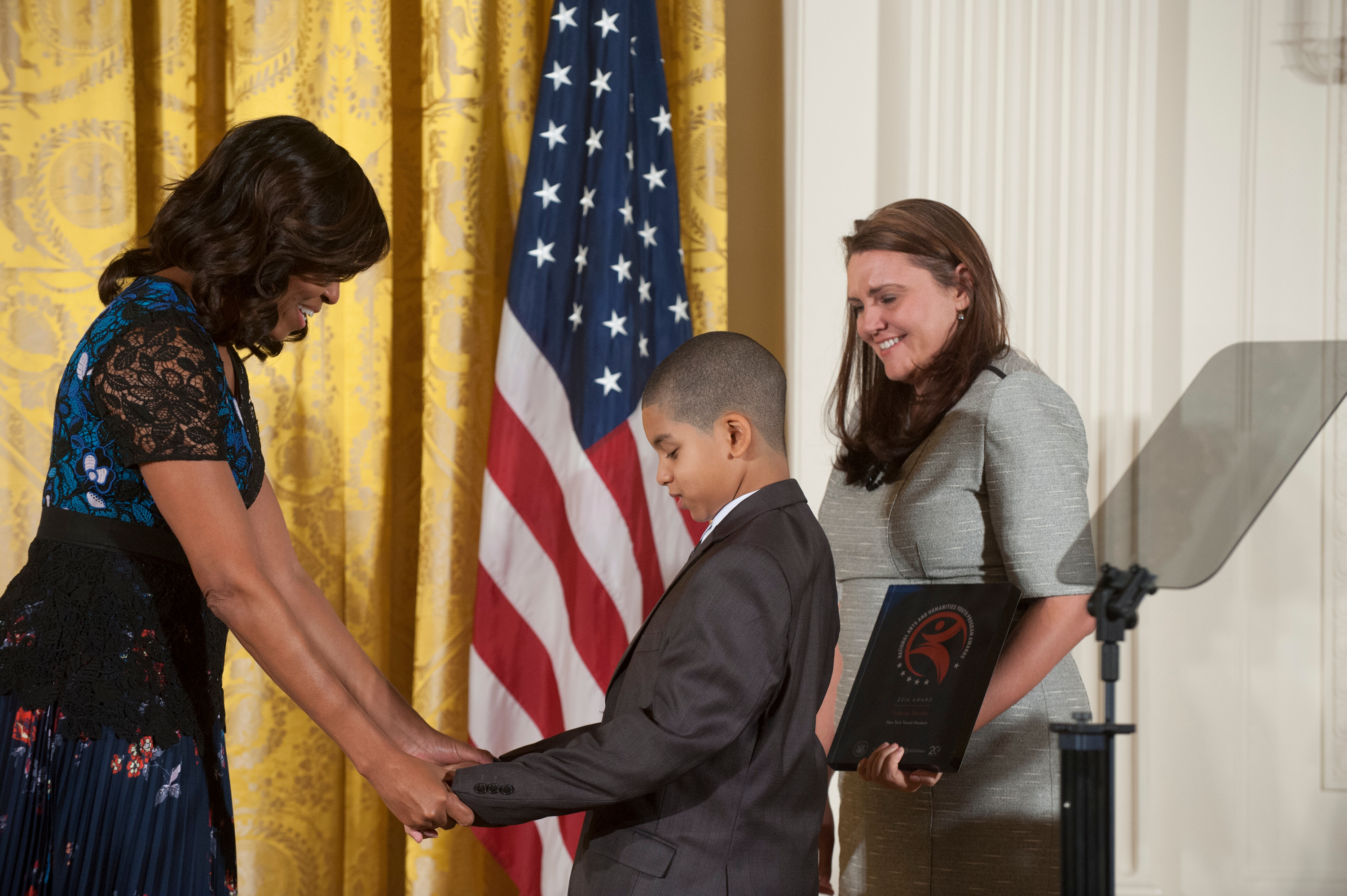WASHINGTON — For the final time as first lady, Michelle Obama honored 12 after-school and out-of-school-time organizations at the White House for the eighth annual National Arts and Humanities Youth Program Awards for creative youth development programs.
A young representative and adult staff member from each organization was recognized on stage and gave Obama a hug to audience applause. A few of the youth were so excited they opened their arms for a second warm embrace. The Sphinx Organization’s Perfect Fourth String Quartet played an impressive finale performance before closing remarks, which Obama said was an example of how young people can do anything they set their minds to.
During her speech, Obama emphasized the importance of continuing the National Arts and Humanities Youth Program after President Barack Obama’s term ends Jan. 20, 2017. “This has been a blast,” she said at the conclusion of the ceremony Tuesday. “We are going to find ways to keep doing this long after we leave the White House.”
The candidate pool began with 251 nominations and was narrowed to 50 finalists. The honorees were selected by the President’s Committee on the Arts and Humanities for achieving a wide range of positive outcomes for the kids they work with, such as developing 21st-century skills, increasing academic achievement, graduation rates and college enrollment.
The award-winning organizations included the Bay Area Video Coalition, Sphinx Organization, West Michigan Center for the Arts and Technology’s Teen Arts + Tech Program, Mexic-Arte Museum, New York Transit Museum’s Subway Sleuths, California Indian Museum and Cultural Center’s Tribal Youth Ambassadors, Kodiak Historical Society’s Baranov Museum Youth History & Film Summer Intensive, Inquilinos Boricuas en Acción’s Youth Development Program, Office on Children & Youth Institute for Innovation in Health & Human Services’ Reading Road Show—Gus Bus, Adrienne Arsht Center for the Performing Arts of Miami-Dade County’s AileyCamp Miami, St. Louis ArtWorks and The Theater Offensive’s True Colors: Out Youth Theater. The international award went to Creative Youth Development in Cuba.
Kim Hartzler-Weakley, the Office on Children & Youth coordinator for children and youth services at the Institute for Innovation in Health and Human Services, said she was especially proud when Obama said she loved the Gus Bus, a mobile library that offers book checkouts and enrichment programs to low-income neighborhoods in Harrisonburg, Virginia. Their mission is to offer literature to kids who can’t reach a library.
Eleven-year-old Gus Bus rider Sarah Hussein said she was nervous about hugging the first lady. “It was really fun and I was just so excited to hug her,” she said.
Hartzler-Weakley said she hopes winning the award will attract donors and sponsors to help them buy two new buses so they can go greater distances than their current two buses allow, which limits the communities the program can reach. One of the most important lessons she has learned through the award-winning program is the importance of reaching kids where they are, she said. Part of the program’s success Hartzler-Weakley also attributed to the staff’s passion and their ability to collaborate with other organizations, area schools and businesses.
Regina Asborno, acting director of the Subway Sleuths of the New York Transit Museum, also hopes to use the acclaim from the award to grow their programming. Subway Sleuths uses the love of subway trains to bring kids with autism, Asperger’s and pervasive developmental disorders together to practice social skills. She hopes the program can grow to include other things teenagers can get excited about, but they are looking for funding to continue operating.
Nine-year-old Subway Sleuth Ian Aquino said he was excited to meet “Mrs. Obama” and thank her for the award. Ian likes the speed and movement of the subway, saying his favorite train is the number 6. “My favorite part about trains are going in them,” he said.
One of the exercises the Subway Sleuths use is for one child to act as toy train track architect and builder. “Through nonverbal communications, moving your head yes and no, the architect instructs the other kid how to build these train tracks,” she said. “It’s those cues that we take for granted of yes, no communication that we can reinforce through the games.”
Asborno said she is excited to talk to members of other programs about ways to get kids excited about learning and building social skills. “We’d love to share everything we’ve learned, through failures and successes, so that we can pass along that information.”
































